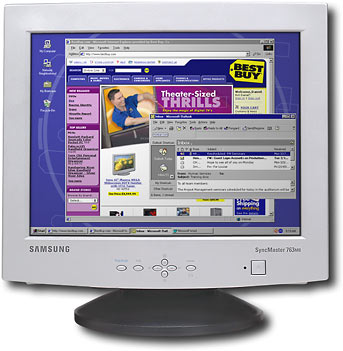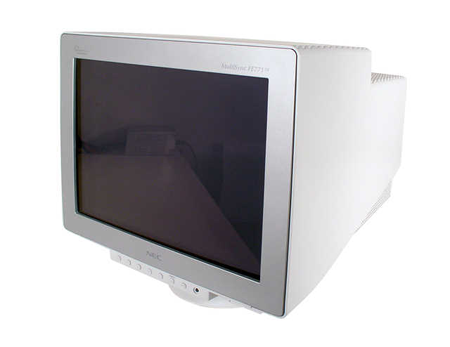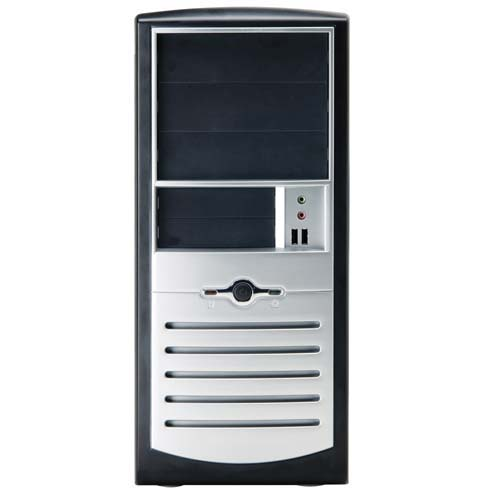Weekly Buyer's Guide: Entry Level System - August 2004
by Anand Shimpi & Larry Barber on August 9, 2004 12:00 PM EST- Posted in
- Guides
Monitor
Recommendation: Samsung SyncMaster 17" Flat-Tube (model 763MB)Price: $150 shipped

Samsung's SyncMaster series of monitors are very popular for price-conscious buyers. With a 0.20mm dot pitch, 1280x1024 max resolution, and 3-year manufacturer warranty, you're getting a good bang-for-your-buck monitor. You can pick up this monitor at your local Best Buy if you don't feel like waiting several days for your monitor to arrive in the mail. We suggest calibrating your monitor for maximum clarity if you do a lot of desktop work. Consult your manual or an online guide on how to calibrate a monitor.
Monitor Alternative: NEC Diamondtron 17" CRT (model FE771SB)
Price: $183 shipped

This NEC model is one of the lower end models of the famous Diamondtron series of monitors. Max resolution is just 1280x1024 and dot pitch is a mediocre 0.25mm. However, the clarity and viewable area (16") of this monitor are better than the Samsung SyncMaster 763MB, and at just about $33 more, it is a nice little upgrade if you're willing to spend the extra dollars.
Computer Case
Recommendation: CaseEdge TS1 Mid TowerPrice: $40 shipped

You can purchase this case online at www.pcclub.com or go to a local PC Club to pick it up. Not only is the black and silver edition of this case very good looking, but the set-up is very easy to use and convenient in general. For one, the motherboard mounting screws come installed in their proper holes, a welcome change from having to screw them in by hand. Secondly, the hard drive and optical drive bays contain plastic clips that allow you to install your drives simply and easily without screws. All in all, this case basically comes "pre-installed", and even includes a 300W PSU (power supply unit). Any AMD or Intel approved power supply will do for a budget system, considering how little power a system like this draws, but if you're feeling extra cautious (thinking about future upgrades), picking up a Sparkle 300W PSU is a fine choice. The price of a Sparkle 300W PSU is about $23 shipped online.
Alternative: Foxconn Super Case 100-G2-P4 Mid Tower
Price: $45 shipped

While this case isn't quite as easy to use or as aesthetically appealing as the CaseEdge TS1, it is still a fine computer case with all the space that you'll need for your budget system. It comes with an AMD approved 300W PSU, but as we said before, you can always opt for a better 300W power supply if you feel like you need an especially good PSU for future upgrades. Still, a free PSU is usually never a bad thing.
In the end, as long as you purchase a case that accepts an ATX motherboard, the choice of computer case is completely up to you, the consumer. There are many aesthetically appealing computer cases out there, so don't let our preferences stop you from exploring other computer cases online or at a local retail outlet like PC Club, Best Buy, CompUSA, etc.










30 Comments
View All Comments
leigh6 - Tuesday, August 10, 2004 - link
Without reading Anandtech's Entry level thread I built an entry level system for my sister in law. Her needs were exactly what you had in your initial description of the build. Coincidentally I used most of your components you recommended. So some comments.1. The Seagate Hardrive was PERFECT. Quiet, fairly inexpensive, plenty of storage wtih 80g and with a now 5 year warranty a no brainer.
2. Radeon 9200se. PERFECT. Absolutely needs nothing better. It does the job and more.
3. Processor was the 2500 Barton . (Would have used the 2000 but had an extra retail 2500 laying around). Either one would have been fine and I do not think there would be a noticable difference for what she and her 3 kids need. WOULD stay with the 2000 for budget reasons and not use this for an upgrade.
4. Case. I though my choice was a no brainer.
Antec slk 2600 with a 300W PS. Not the prettiest case. But for the same price as your model ($65.00) I thought was a much better choice.
5. Ram. Happen to use 512 Kingston Value Ram DDR 3200. (With many rebates available on this product the final price comes to around $75.00) direct from Kingston.
6. Motherboard. I wish I had read this before the build. But I did get lucky. The motherboard I am using has been rock solid. But the next build will be with you're recomendation.
Now a suggestion for the overall concept of your article.
30 percent of the price of the system is the monitor. I believe that the keyboard, mouse, speakers and MONITOR should be left out of you base price. I think adding the monitor to the final base price of the system unintentionally makes the price look like it is a little too high to be a budget system and running closer to the low end of "Mid Range". So the base price would be $372.00 and NO ONE would agrue the merits. Then seperately discuss the peripherals with prices and then add them WITH Monitor, Keyboard, Mouse, and Speakers. (Most have these already before there build).
Just my thoughts, Leigh
gherald - Tuesday, August 10, 2004 - link
Here we go again, same as last month...The reason to use a 9200SE rather than an onboard nforce2 is text quality. People who build entry level systems care about this sort of thing, and for this a cheap ATI is clearly better than an onboard nforce unless you happen to use Linux, for which ATI drivers suck :(
To #2 and whoever else mentions Doom 3 or a better 3D video card: congratulations on COMPLETELY MISSING THE POINT of "entry level," now get lost.
As for the case, #4 is a good case in point (bad pun) but we've been through this before. None of us understand what Evan/Anand have against Antec, but they are clearly a better case choice in *every* respect *including* price, and that's pretty much been the consensus for as long as these guides have been around.
512mb is allways a good idea, even if you're just running xp + wordpad + browser... it can be used for other things like DISK CACHE. There's simply no reason to build a system with only 256mb nowdays unless you are a total bum or live in some third world country and thus cannot afford a decent setup.
As for dual channel, I wouldn't worry about it. My preference for entrys has always been a single stick of 512mb since I feel that will be more useful 2-3 years from now when it comes time to disassemble this system and spread the components around to other ones, but that's just me. If 2x256mb works for you then so be it, just be sure you get a motherboard that supports dual channel well, such as the NF7/AN7 from Abit.
cosmotic - Monday, August 9, 2004 - link
Sorry, I thought all nf2s had dual channel... And I've never used a video card (intigrated or otherwise) that could not handle high resolution, although I rarely use integrated video cards.maybe theres hould be an extreme value system, value, best bang-for-buck, overclock, and super high end system buyers guide.
VIAN - Monday, August 9, 2004 - link
sorry bout thatVIAN - Monday, August 9, 2004 - link
I am completely fine with a Web Surfing system having 256MB of RAM, without integrated graphics, it's probably already too much. LOL.You don't need 512MB for Web Surfing. 512MB is what's recommended today for gaming at least, in early 2003, it was 256MB the least. Why would Web Surfers need more than that.
Unless you're setting up some kind of CHEAPO server, there would be no reason for more than 256MB.
Cocophone - Monday, August 9, 2004 - link
#13The machine I'm upgrading from is a 1gHz Celeron with 128 ram with Windows 2000.
I use it as a media server and web stuff and it swaps out the memory far to often. There is nothing worst than swapping out to the hard drive.
For me 512 MB of ram was worth the extra cost. Like #14 says upgrading to 512 ram is more noticable than going from 3 to 2.5 latency.
Degrador - Monday, August 9, 2004 - link
Ok, a few things here...We've been saying in these comments for about the last 5 entry articles that 512MB is a far better option than 256MB with low latency, so even if the recommended isn't 512MB, at least make the alternative more ram instead. Lower latency is never going to give a noticeable improvement to an entry user - it bearly gives a noticeable improvement at any stage.
Also, the nforce 2 integrated video is a much better option than buying a 9200SE. The only reason a 9200SE might be more preferable is if you'd think about swapping over the motherboard at some other stage. However an entry purchaser is likely not to do that, at the very least, not for quite some time. This'll likely be when PCI Express has taken over, and even if it isn't, swapping over a motherboard would likely mean practically new everything for an entry user.
#13
While practically nothing requires 512MB RAM, it can also be said that practically nothing requires more than a pentium 1 processor, but having an athlon xp / 512MB of ram is certainly going to be a better option. Especially for future usage. And while the price is the most important factor, every entry level purchaser wants to keep their system for a long time. So simply recommending the cheapest components would make for a useless article - the underlying purpose behind these articles is to give people an indication of what they should buy. And as most people have been saying, everyone wanting to keep their computer for more than a year should seriously be considering at least 512MB of memory.
PotatoMAN - Monday, August 9, 2004 - link
I really think that for an entry level system it is hard to fight for 512 mbytes of RAM over 256 - Win XP pro runs OK on 128 let alone 256 - so why spend more for performance on an entry level system? Granted, we want the user to use the computer for ~1.5 years w/out the hassle of upgrading/tampering with the machine, but the major focus of the article is price. To my knowledge, I can't recall any programs that REQUIRE 512 of RAM other than games.PrinceGaz - Monday, August 9, 2004 - link
#9- I see you went for 512MB for your bargain system, a very wise choice.Given the intention of the article is to recommend something which you can: "keep this entry level system for quite a long time without modification (read: at least 1.5 years)", after it recommended a stick of cheap 256MB Crucial RAM for the memory, why was the alternative not a cheap 512MB stick, instead of a lower latency 256MB stick? 512MB instead of 256MB is the biggest performance improvement you could make to that system if its going to be running Windows XP. If people building it are expected to run Windows 98SE or a Linux variant, you should clearly state that at the start of the article. Windows 98SE is very much on its last legs already though, so its not a very good recommendation.
Apart from the memory issue, a good selection of components.
VIAN - Monday, August 9, 2004 - link
#5Dual channel is less reliable and adds price. You would have to buy a mobo capable of Dual channel add 30 bucks for that and then two sticks of RAM, try finding 128MB sticks, hah, another 40 bucks. Not worth the performance increase.
I agree, though, that if you are going all out on a "Web Surfing System", an integrated card might have been just as good and cheaper. You want price and speed is the last, so why wouldn't you go integrated.
#8
You make a very good arguement against integrated, but the monitor's optimal resolution is most likely 1024x768, so it wouldn't make a difference.